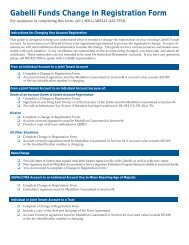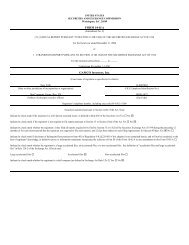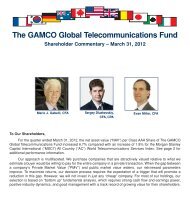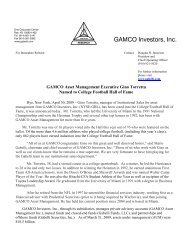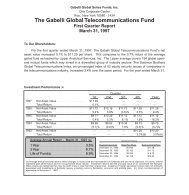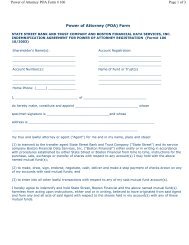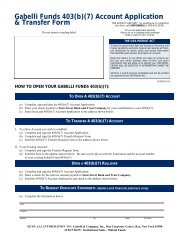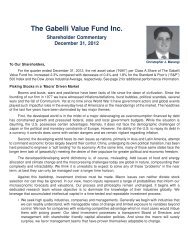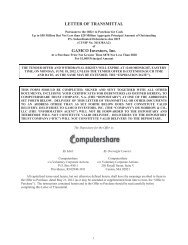Statement of Additional Info - Gabelli
Statement of Additional Info - Gabelli
Statement of Additional Info - Gabelli
You also want an ePaper? Increase the reach of your titles
YUMPU automatically turns print PDFs into web optimized ePapers that Google loves.
other redress. If a Fund is unable to recover any loss to itself, it is the position <strong>of</strong> the SEC that the Distributor will be<br />
immediately obligated to make such Fund whole.<br />
To minimize expenses, a Fund reserves the right to redeem, upon not less than 30 days’ notice, all shares <strong>of</strong> a Fund in an<br />
account (other than an IRA) which as a result <strong>of</strong> shareholder redemption has a value below $1,000 and has reserved the<br />
ability to raise this amount to up to $10,000. However, a shareholder will be allowed to make additional investments<br />
prior to the date fixed for redemption to avoid liquidation <strong>of</strong> the account.<br />
The Mighty Mites Fund, the SmallCap Equity Fund, the Mid-Cap Equity Fund, and the Income Fund generally impose a<br />
redemption fee <strong>of</strong> 2.00% <strong>of</strong> the total redemption amount if shareholders sell or exchange shares within seven days or less<br />
after the purchase date. See “Redemption <strong>of</strong> Shares” in the Funds’ Prospectuses.<br />
Breakpoints, Volume Discounts, and Sales Charge Waivers. Please read the Funds’ Prospectuses for information on<br />
breakpoints, Volume Discounts, and sales charge waivers, if any.<br />
DETERMINATION OF NET ASSET VALUE<br />
NAV per share is calculated separately for each class <strong>of</strong> each Fund. The NAV <strong>of</strong> Class C Shares <strong>of</strong> each Fund will<br />
generally be lower than the NAV <strong>of</strong> Class A, Class I, or Class AAA Shares, as applicable, as a result <strong>of</strong> the higher service<br />
and distribution-related fees to which Class C Shares are subject. It is expected, however, that the NAV <strong>of</strong> each class will<br />
tend to converge immediately after the recording <strong>of</strong> dividends, if any, which will differ by approximately the amount <strong>of</strong><br />
the distribution and/or service fee expense accrual differential among the classes.<br />
Portfolio securities listed or traded on a nationally recognized securities exchange or traded in the over-the-counter<br />
market for which market quotations are readily available are valued at the last quoted sale price or a market’s <strong>of</strong>ficial<br />
closing price as <strong>of</strong> the close <strong>of</strong> business on the day the securities are being valued. If there were no sales that day, the<br />
security is valued at the average <strong>of</strong> the closing bid and asked prices, or, if there were no asked prices quoted on that day,<br />
the security is valued at the closing bid price on that day. If no bid or asked prices are quoted on such day, the security is<br />
valued at the most recently available price, or, if the Board so determines, by such other method as the Board shall<br />
determine in good faith, to reflect its fair market value. Portfolio securities traded on more than one national securities<br />
exchange or market are valued according to the broadest and most representative market, as determined by the Adviser.<br />
Portfolio securities primarily traded on a foreign market are generally valued at the preceding closing values <strong>of</strong> such<br />
securities on their respective exchanges, but may be fair valued pursuant to procedures established by the Board if market<br />
conditions change significantly after the close <strong>of</strong> the foreign market but prior to the close <strong>of</strong> business on the day the<br />
securities are being valued. Debt instruments with remaining maturities <strong>of</strong> 60 days or less that are not credit impaired<br />
are valued at amortized cost, unless the Board determines such amount does not reflect the securities’ fair value, in which<br />
case these securities will be fair valued as determined by the Board. Debt instruments having a maturity greater than<br />
sixty days for which market quotations are readily available are valued at the average <strong>of</strong> the latest bid and asked prices.<br />
If there were no asked prices quoted on such day, the security is valued using the closing bid price. Futures contracts are<br />
valued at the closing settlement price <strong>of</strong> the exchange or board <strong>of</strong> trade on which the applicable contract is traded.<br />
Securities and assets for which market quotations are not readily available are valued at their fair value as determined by<br />
the Board. Fair valuation methodologies and procedures may include, but are not limited to: analysis and review <strong>of</strong><br />
available financial and non-financial information about the company; comparisons to the valuation and changes in<br />
valuation <strong>of</strong> similar securities, including a comparison <strong>of</strong> foreign securities to the equivalent U.S. dollar value ADR<br />
securities at the close <strong>of</strong> U.S. exchanges; and evaluation <strong>of</strong> any other information that could be indicative <strong>of</strong> the value <strong>of</strong><br />
the security.<br />
The Funds may obtain valuations on the basis <strong>of</strong> prices provided by a pricing service approved by the Board . All other<br />
investment assets, including restricted and not readily marketable securities, are valued in good faith at fair value under<br />
procedures established by and under the general supervision and responsibility <strong>of</strong> the Trust’s Board. Further information<br />
on fair valuation is provided in the Funds’ Prospectuses under “Pricing <strong>of</strong> Fund Shares.”<br />
In addition, whenever developments in one or more securities markets after the close <strong>of</strong> the principal markets for one or<br />
more portfolio securities and before the time as <strong>of</strong> which a Fund determines its NAV would, if such developments had<br />
been reflected in such principal markets, likely have more than a minimal effect on such Fund's NAV, the Fund may fair<br />
value such portfolio securities based on available market information as <strong>of</strong> the time the Fund determines its NAV.<br />
65




